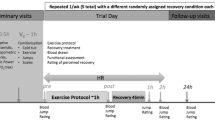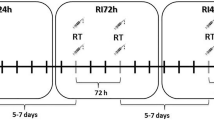Abstract
Introduction
Cold-water immersion (CWI) is often used to promote recovery by reducing exercise-induced muscle damage, soreness, and inflammation. However, recent reports have cautioned that CWI may attenuate the adaptive response to resistance training.
Purpose
To determine the effect of post resistance-exercise CWI on circulating free testosterone (T) and cytokine (IL-6 and TNF-α) response.
Methods
Using a randomized and counterbalanced repeated-measures design, 11 resistance-trained men completed two workouts (6 sets of 10 repetitions of back squats at 80% of maximum load) a week apart after which they took part in either 15 min of CWI (15 °C) or passive recovery. T, IL-6, and TNFα were measured in blood samples taken before (PRE) and 5 (5POST), 15 (15POST), 30 (30POST), and 60 (60POST) min post-exercise and compared between treatments and over time.
Results
For T, a significant interaction effect of condition over time (p = 0.030) as well as greater relative concentrations of T in CON (Δ9.2%) than CWI (Δ-0.5%, p = 0.049) at 30POST were observed. In addition, at 60POST, T dropped below PRE values in CWI (Δ-10.4%, p = 0.028) but not in CON (Δ-1.6%, p = 0.850). A suppressed cytokine response was observed after CWI in IL-6 at 30POST (CWI: Δ4.9%, CON: Δ47.5%, p = 0.041) and TNFα at 15POST (CWI: Δ5.3%, CON: Δ17.0%, p = 0.022).
Conclusions
CWI blunted the T and cytokine response after a bout of resistance exercise. These results indicate that CWI results in an altered anabolic response and may help to explain the previous observation of attenuated hypertrophy when CWI is used after resistance exercise.



Similar content being viewed by others
Abbreviations
- 1RM:
-
Back squat one repetition maximum
- BM:
-
Body mass
- CON:
-
Passive control condition
- CWI:
-
Cold-water immersion condition
- IL-6:
-
Interleukin-6
- POST:
-
Post-exercise time point (5, 15, 30 or 60 min)
- PRE:
-
Pre-exercise time point
- T:
-
Free testosterone
- TNFα:
-
Tumor necrotic growth-factor alpha
References
Abaidia AE, Lamblin J, Delecroix B, Leduc C, McCall A, Nedelec M, Dawson B, Baquet G, Dupont G (2017) Recovery from exercise-induced muscle damage: cold water immersion versus whole-body cryotherapy. Int J Sports Physiol Perform 12(3):402–409
Basualto-Alarcon C, Jorquera G, Altamirano F, Jaimovich E, Estrada M (2013) Testosterone signals through mTOR and androgen receptor to induce muscle hypertrophy. Med Sci Sport Exer 49(5):1712–1720
Burke DG, MacNeil SA, Holt LE, Mackinnon NC, Rasmussen RL (2010) The effect of hot or cold water immersion on isometric strength training. J Strength Cond Res 14(1):21–25
Crystal NJ, Townson DH, Cook SB, LaRoche DP (2013) Effect of cryotherapy on muscle recovery and inflammation following a bout of damaging exercise. Eur J Appl Physiol 113(10):2577–2586
Eston R, Peters D (1999) Effects of cold water immersion on the symptoms of exercise-induced muscle damage. J Sports Sci 17(3):231–238
Febbraio MA, Pedersen BK (2002) Muscle-derived interleukin-6: mechanisms for activation and possible biological roles. FASEB J 16(11):1335–1347
Frohlich M, Faude O, Klein M, Pieter A, Emrich E, Meyer T (2014) Strength training adaptations after cold-water immersion. J Strength Cond Res 28(9):2628–2633
Grasso D, Lanteri P, Di Bernardo C, Mauri C, Procelli S, Colombini A, Zani V, Bonomi FG, Melegati G, Banfi G, Lombardi G (2014) Salivary steroid hormone response to whole-body cryotherapy in elite rugby players. J Biol Regul Homeost Agents 28(2):291–300
Hooper DR, Kraemer WJ, Focht BC, Volket JS, DuPont WH, Calkwell LK, Maresh CM (2017) Endocrinology roles for testosterone in resistance exercise responses and adaptations. Sports Med 47(9):1709–1720
Juarez-Rojas AL, Garcia-Lorenzana M, Aragon-Martinez A, Gomez-Quiroz LE, Retana-Marquez Mdel S (2015) Syt Biol Reprod Med 61(4):211–221
Kraemer WJ, Ratamess NA, Fry AC, French DN (2005) Strength training: development and evaluation of methodology. Physiological assessment of human fitness, 2nd edn. Human Kinetics Publishers, Champaign, pp 119–150
Kraemer WJ, Ratamess NA, Nindl BC (2017) Recovery responses of testosterone, growth hormone, and IGF-1 after resistance exercise. J Appl Physiol 122(3):549–558
Machado AF, Ferreira PH, Micheletti JK, de Almeida AC, Lemes IR, Vanderlei FM, Netto Junior J, Pastre CM (2016) Can water temperature and immersion time influence the effect of cold water immersion on muscle soreness? A systematic review and meta-analysis. Sports Med 46(4):503–514
Morita M, Gravel SP, Hulea L, Pollak M, St-Pierre J, Topisirovic I (2015) mTOR coordinates protein synthesis, mitochondrial activity and proliferation. Cell Cycle 14(4):473–480
Peake JM, Roberts LA, Figueirdeo VC, Egner I, Krog S, Aas SN, Suzuki K, Markworth JF, Coombes JS, Cameron-Smith D, Raastad T (2017) The effects of cold water immersion and active recovery on inflammation and cell stress responses in human skeletal muscle after resistance exercise. J Physiol 595(3):695–711
Roberts LA, Nosaka K, Coombes JS, Peake JM (2014) Cold water immersion enhances recovery of submaximal muscle function after resistance exercise. Am J Physiol Regul Integr Comp Physiol 307(8):R998–R1008
Roberts LA, Raastad T, Markworth JF, Figueiredo VC, Egner IM, Shield A, Cameron-Smith D, Coombes JS, Peake JM (2015) Post-exercise cold water immersion attenuates acute anabolic signaling and long-term adaptations in muscle to strength training. J Physiol 593(18):4285–4301
Roberts LA, Muthalib M, Stanley J, Lichtwark G, Nosaka K, Coombes JS, Peake JM (2017) Effects of cold water immersion and active recovery on hemodynamics and recovery of muscle strength following resistance exercise. J Physiol 595(3):695–711
Rose C, Edwards KM, Siegler J, Graham D, Caillaud C (2017) Whole-body cryotherapy as a recovery technique after exercise: a review of the literature. Int J Sports Med 28:1049–1060
Russell M, Birch J, Love T, Bracken RM, Taylor T, Swift E, Cockburn E, Finn C, Cunningham D, Wilson L, Kilduff LP (2017) The effects of a single whole-body cryotherapy exposure on physiological, performance and perceptual responses of professional academy soccer players after repeated sprint exercise. J Strength Cond Res 31(2):415–421
Urhausen A, Gabriel H, Kindermann W (1995) Blood hormone markers of training stress and overtraining. Sports Med 20(4):251–276
Versey NG, Halson SL, Dawson BT (2013) Water immersion recovery for athletes: effects on exercise performance and practical recommendations. Sports Med 43(11):1101–1130
Wang X, Proud CG (2006) The mTOR pathway in the control of protein synthesis. Physiology (Bethesda) 21:362–369
White JP, Gao S, Puppa MJ, Sato S, Welle SL, Carson JA (2013) Testosterone regulation of Akt/mTORC1/Fox03a signaling in skeletal muscle. Mol Cell Endocrinol 365(2):174–186
Wilcock IM, Cronin JB, Hing WA (2006) Physiological response to water immersion. Sports Med 36(9):747–765
Yamane M, Teruya H, Nakano M, Ogai R, Ohnishi N, Kosaka M (2006) Post-exercise leg and forearm flexor muscle cooling in humans attenuates endurance and resistance training effects on muscle performance and on circulatory adaptation. Eur J Appl Physiol 96(5):572–580
Ziemann E, Olek RA, Sylwester K, Grzywacz T, Antosiewicz J, Garsztka T, Lasowski R (2012) Five-day whole-body cryostimulation, blood inflammatory markers, and performance in high-ranking professional tennis players. J Athl Train 47(6):664–672
Acknowledgements
Partial financial support for this study was provided by an Enhancement of Graduate Research Award from the University of Rhode Island.
Author information
Authors and Affiliations
Corresponding author
Ethics declarations
Conflict of interest
The authors declare that they have no conflict of interest.
Additional information
Communicated by Philip D. Chilibeck.
Publisher's Note
Springer Nature remains neutral with regard to jurisdictional claims in published maps and institutional affiliations.
Rights and permissions
About this article
Cite this article
Earp, J.E., Hatfield, D.L., Sherman, A. et al. Cold-water immersion blunts and delays increases in circulating testosterone and cytokines post-resistance exercise. Eur J Appl Physiol 119, 1901–1907 (2019). https://doi.org/10.1007/s00421-019-04178-7
Received:
Accepted:
Published:
Issue Date:
DOI: https://doi.org/10.1007/s00421-019-04178-7




